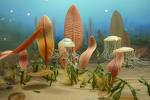 |
 |
 |
 |
 |
Produced
by the Population Genetics and Evolution class, Furman University |
||||
 |
 |
 |
 |
 |
Produced
by the Population Genetics and Evolution class, Furman University |
||||
 |
The
Ediacaran: Ediacaria |
 |
| Ediacaria
are one of the oldest living organisms that existed during the Precambrian
Proterozoic Era roughly 600 million years ago (Knoll 1999). For a while
they were thought to be medusoid cnidarians, but other scientists suggest
they may be imprints of benthic polyps or the result of disturbed sediments
surrounding the holdfasts of frond-like animals. Another hypothesis is
that these structures are the imprints of bacterial mats. These mats can
form central discs and conentric rings, especially when stressed by environmental
pressures (Grazhdankin 2001). More recent findings in Zimnii Bereg in
2002 found imprints revealing an organism with three concentric zones
containing radial structures that increased in density but were reduced
in thickness as they radiated from the center outwards. The ring size
increase is hypothesized to correlate with age. In addition, stem-like
structures seem to rise from the central disc, reinforcing the hypothesis
that these are holdfasts of other organisms, not entire organisms in their
own right (Serezhnikova 2004).
Page by Iggy Gaska |
 |
| Fossil of Ediacaria, from the Peabody Museum of Natura
History, Yale University. |
|
| Grazhdankin D. 2001. Microbial origin
of some of the Ediacaran fossils. Abstract of a paper presetned at the
Annual Meeting of the Geological Society of America, 2001.
Knoll AH, Carroll BS. 1999 Early animal evolution: Emerging views from comparative biology and gcology. Science 284: 2129-2137. Serezhnikova EA. 2004. Ediacaria and Hiemalora – disc-like attachments of benthic organisms from the White Sea and Arctic Siberia (Russia). Abstract volume for IGCP493 Workshop – The Rise and Fall of the Vendian Biota, 30-31 August, Prato: 90-93. |